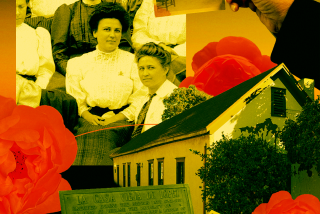Retiree’s Service to Mission San Juan Capistrano Is Matter of Record
When he was 56 and had been behind a bank desk for 26 years, Charles Bodner retired to see the country he had fought for as a U.S. Army officer in Africa during World War II.
Bodner, now 74, and his wife Catherine, 71, wandered through the states for 13 years. But as fate would have it, he is back behind a desk.
This time it’s in a windowless fourth-floor office, where he organizes Mission San Juan Capistrano archives, which date to 1778.
“Look at me now,” said Bodner. “I’m back to where I started.”
Clearly, his work in the archive is more a labor of love, although he receives a small salary for his three-day-a-week job that is interrupted daily at noon by the three-minute tolling of the mission’s 12 bronze bells in the belfry directly over his office.
Until Bodner started reorganizing them in 1985, the archives had lain untouched since the first archivist died in 1979.
One of his first moves was to provide a fireproof and acidproof cabinet to hold the church’s oldest and most delicate docments, which include baptismal records signed by Father Junipero Serra, who founded the mission, the seventh of 21 in California.
Some of the papers are so delicate, Bodner often wears white gloves to protect them, he said. The archive contents include books on Spanish theology, photographs, newspaper clippings and the first telephone in San Juan Capistrano.
The phone number is 1.
The archive also holds the proclamation signed in 1865 by President Abraham Lincoln returning the mission from private hands to the Diocese of Los Angeles.
“I’ve read a good portion of everything in the archives,” said Bodner, who also binds many of the books he creates from the records. “I’m also finding some little-known facts that Father Serra wrote.”
He provides much of the information to research people and college students who are working on the history of the mission, noting that he likes “to give knowledge to young people. They don’t get a lot of this in school.”
Although he feels his work is nearly finished, “Each day I find something new that helps unfold the activities and the trials and tribulations of the Indians and people who lived in the mission,” Bodner said. “Life at that time was very difficult.”
For example, missionaries had to wear their habits until they were threadbare. “Ships with supplies only came in every other year,” he said.
Despite his voracious reading of the archive records, “I seem to be missing a certain kind of note written by Father Serra that said he was praying for the success of George Washington’s army against the British. I keep looking through the old books hoping it will turn up on a margin of a page somewhere.”
The former bank executive has done other work for the mission.
After retirement, Bodner toiled for five years as the volunteer caretaker of the old Mission Cemetery, which is located around the corner from his San Juan Capistrano home near Ortega Highway.
“I worked up a pretty good sweat cleaning the brush away, putting up new crosses and bringing it up to park standards,” said Bodner, who remembers that he had always wanted to work outdoors when he was deskbound at the bank.
Now, Bodner says, while he sometimes visits the mountains, “I do miss my retirement. Once I find that note by Father Serra. . . .”
Valerie Millett, 29, thought her life was aimed at a career in medical technology until a class project at Fullerton College sent her in another direction.
“I was assigned to illustrate a surgeon in action,” said Millett, who is studying advertising and design, but earlier worked as a medical technical assistant in an operating room.
“I took some pictures of the surgeon at work and then I did a watercolor from it.”
Millett’s teacher gave her an A on the project and the surgeon gave her $300 for the 2-foot-by-3-foot painting.
She did a painting of another surgeon and he paid her a similar amount.
“If I can keep it up,” Millett said, “it has potential for a good business, and I wouldn’t have to get a full-time job while I’m going to college.”
More to Read
Sign up for Essential California
The most important California stories and recommendations in your inbox every morning.
You may occasionally receive promotional content from the Los Angeles Times.









